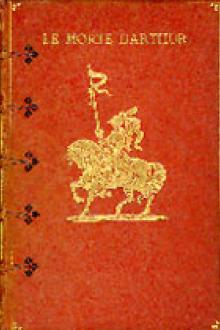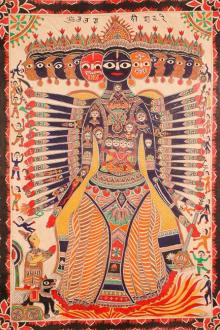Olaf the Glorious: A Story of the Viking Age, Robert Leighton [best ebook reader .TXT] 📗

- Author: Robert Leighton
Book online «Olaf the Glorious: A Story of the Viking Age, Robert Leighton [best ebook reader .TXT] 📗». Author Robert Leighton
Thus Olaf Triggvison had made both the Danes and the Swedes take to flight, and it had all befallen as he had said.
And now it must be told how Earl Erik Hakonson fared in that fight. True to the agreement which he and the two allied kings had come to over their dice throwing on the morning of that same fateful day, he had stood apart from the battle while Sweyn had vainly striven to make a prize of the Long Serpent; and during the midday and until the retreat of King Sweyn he had engaged no more in the conflict than to direct his arrows from afar into the thick of Olaf Triggvison's host. Now, Earl Erik was wise in warfare, and a man of keen judgment. He had fought with his father in the great battle against Sigvaldi and the vikings of Jomsburg, and from what he had seen on that day of Olaf Triggvison's prowess, and from what he had since heard of Olaf's warfare in England and other lands, he had made a very true estimate of the man who now fought in defence of the Long Serpent. He had also seen Sweyn Forkbeard in the thick of battle, and Olaf of Sweden no less. He was, therefore, well able to judge that neither the king of the Danes nor the king of the Swedes was capable of overcoming so brave and mighty a warrior as the king of the Norsemen, or of wresting the Long Serpent from the man who had built her and who knew so well how to defend his own. Pride in his own countryman may have had some share in the forming of this opinion. But Earl Erik had fought against the men of every land in Scandinavia. He had a firm belief that the men of Norway were braver and bolder, stronger in body, more skilful in the use of their weapons, and had greater powers of endurance than any of their neighbours. And it may be that in this he was right. He at least saw cause for thinking that the only men who could succeed in vanquishing King Olaf's Norsemen were the Norsemen of Earl Erik Hakonson. Earl Erik's vikings and berserks, eagerly watching the fray, had seen how the Danish ships had one after another been driven off, disabled and defeated. They had watched every movement of the tall and splendid form of the Norse king as he fought in his shining armour and his bright red tunic on the Serpent's lypting. For a time they had not been certain whether Olaf Triggvison was at the stem or on the poop of his great dragonship, for it was seen that at each of these important points there was a tall chief whose prowess and whose attire alike distinguished him from all other men; and these two champions so resembled one the other that it was not easy to tell which was Kolbiorn Stallare and which King Olaf. But Earl Erik had not a moment's doubt. He would have known Olaf Triggvison had a score of such men as Kolbiorn been at his side. Earl Erik was the eldest son of the evil Earl Hakon who had fled from Thrandheim at the time of Olaf's coming into Norway, and been slain while taking refuge at the farmstead of Rimul, and Erik had naturally hoped that on his father's death he would succeed to the throne. Olaf Triggvison had shattered all his plans of future glory; and during the five years that had already passed of King Olaf's reign he thirsted for such an opportunity as now presented itself, not only of avenging his father's death but also, it might be, of placing himself upon the throne of Norway. His only uneasiness at the present moment arose from his fear lest King Olaf should be overcome in the battle ere he had himself encountered him face to face and hand to hand.
While the King of Sweden and his forces were engaged with their attack upon Olaf's centre of battle, Earl Erik adopted a plan which, although seemingly more hopeless, was in the end more successful than any that had yet been attempted by either the Danes or the Swedes. He saw that while the Long Serpent continued to be supported on either side by five strong and well manned dragonships she was practically unassailable. Her poop and her prow were the only points of her hull that were exposed, and these towered so high above the bulwarks of all other vessels that to attempt to board her was both useless and dangerous. Herein lay the secret of Olaf's successful defence, the proof of his forethought and wisdom in building the Serpent so much larger and higher than all other vessels in his fleet. Earl Erik, indeed, had observed that every ship that had approached her, either fore or aft, had been in its turn completely cleared of men or forced to withdraw out of the conflict.
Urging his rowers to their fullest speed, Erik bore down with his ships upon the extreme of King Olaf's right wing. The heavy, iron bound bow of the Ram crashed into the broadside of Olaf's outermost longship, whose timber creaked and groaned under the impact. Vikings and berserks leapt down upon her decks, and now Norseman met Norseman in a terrible, deadly combat. The king's men were well nigh exhausted with the long day's fighting under the hot sun; their bronzed faces streamed with perspiration, their limbs moved wearily. But, however, tired and thirsty they were, they could give themselves no respite. Every man that fell or was disabled by wounds left a gap in the ranks that could not be filled. The earl's men were fresh and vigorous; they had waited for hours for their chief's orders to enter the fray, and now that those orders had been given to them they fought with hot fury, yelling their battle cries and cutting down their foemen with ponderous axe and keen edged sword.
So fierce was the onslaught that many of Olaf's men, for the first time that day, fell back in fear and clambered over the bulwarks of the next ship. Very soon the decks of the first longship were completely cleared of defenders. Then Earl Erik backed out with the Iron Ram, while the seamen on his other ships cut away the lashings that had bound Olaf's outermost vessel to her neighbour, and drew the conquered craft away into the rear, leaving the next ship exposed.
Again Earl Erik advanced with the Ram and crashed as before into the exposed broadside of the outermost ship. As before, the vikings leapt on board and renewed the onset. Five of the viking ships lay with their high prows overshadowing the broadside bulwarks, and their men swarmed and clamoured upon the decks from stem to stern, clearing all before them. Again the lashings were cut and the conquered longship was withdrawn.
Two of King Olaf's dragons had now been captured by Earl Erik. It was not very long ere yet two others followed; and then the Short Serpent was exposed, even as her four companions had been. At this juncture Earl Erik paused, for he saw that Thorkel Nefja's decks were densely crowded with men who had retreated from vessel to vessel before the onslaught of the vikings. With the caution which long years of viking work had taught him, the earl decided that the Short Serpent might best be assailed by means of arrows, fired from a safe distance, until her numbers had been sufficiently diminished to warrant his attacking her at closer quarters. So he arrayed six of his ships near hand and set his archers to work, and for a long while this method of assault was continued.
There was no lack of arrows on the Short Serpent, or indeed, on any other of King Olaf's battleships. But it was noticed by the earl's vikings that the larger number of the shafts that were shot at them by the defenders were of Danish or Swedish make, and by this it was judged that the king's men were using the arrows that had been fired upon them by their enemies.
Leaving his six ships where he had stationed them, Earl Erik now rowed the Iron Ram round to the left wing of Olaf Triggvison's array. Four of his best longships followed him. He passed astern of the king's fleet. As he rowed by under the poop of the Long Serpent he saw the majestic figure of the King of Norway, looking brilliant in gold and scarlet as he stood in flood of the afternoon sunlight, sword in hand and shield at breast. The eyes of the two bravest of Norse warriors met. Waving his sword in mock salute, Earl Erik cried aloud:
"Short will be Olaf's shrift when Erik boards the Long Serpent!"
King Olaf saw that near to where Erik stood, on the Iron Ram's forward deck, the image of the god Thor was raised, and he cried aloud in answer:
"Never shall Erik board the Serpent while Thor dwells in his stem!"
"A wise soothsayer is the king," said Earl Erik to one of his warriors as he passed onward astern of the Crane. "And I have been thinking, ever since this battle began that the great luck of Olaf may be due to that sign of the cross that we see on all his banners and shields. Often have I felt a wish to turn Christian, for it seems to me that all Christian men have something noble and honest about them--a greatness which we heathens can never achieve. Now do I swear upon the hilt of my sword"--he raised his sword hilt to his lips--"that if I win this battle and take the Long Serpent for my prize I will straightway allow myself to be christened. And, to begin with, I will have that image of Thor thrown overboard into the sea. It is ill made and cumbrous, and a figure of the cross will take less room in our stem and bring us more luck withal."
So speaking, Earl Erik stepped forward and, gripping the idol in his strong arms, flung it over the bulwark. Then he lashed two spars together, a long plank crossed with a shorter one, and raised this rough made crucifix high in the stem of the Iron Ram. By this time his vessel had passed beyond the extreme of King Olaf's left wing. He bade his rowers stop their rowing on the starboard side. They did so, and the ship turned about. Then at fullest speed he bore down upon the king's outermost dragon, crashed into her side and renewed his onslaught.
Erik dealt with the left wing as he had done with the right, and one after another of the four ships was cleared and unlashed. And now the Long Serpent lay with only two companions, the Short Serpent at her starboard and the Crane at her larboard side.
Already the Short Serpent was greatly crippled. Her commander, Thorkel Nefja, had fallen, and the larger number of her men





Comments (0)